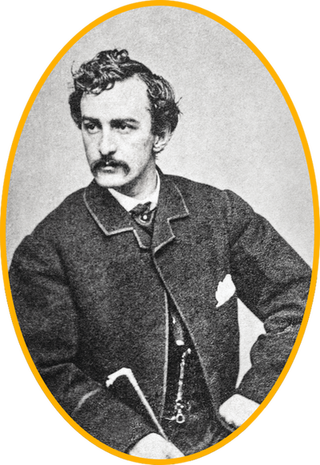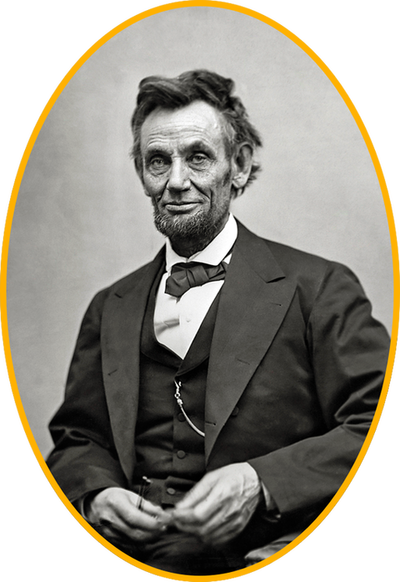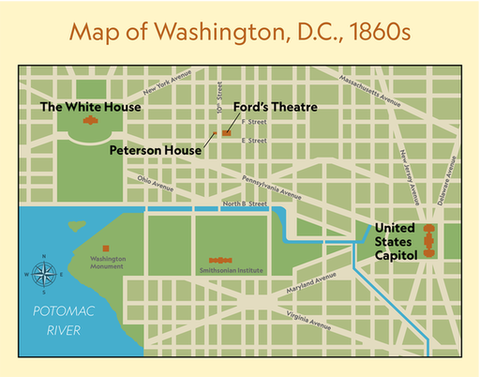OnthenightofApril14,1865,PresidentAbrahamLincolnwenttoFord’sTheatreinWashington,D.C.HeandMrs.Lincolnsatinaspecialboxabovethe stage.
Duringtheplay,amanenteredthebox.HewasafamousactornamedJohnWilkesBooth.BoothwasupsetoverhowtheCivilWarhadended.HeblamedLincoln.HeaimedagunatLincolnandfired.Chaos followed.
Boothquicklyleapedontothestage.Onthewaydown,oneofhisbootscaughttheedgeofaflag.Boothstumbledandbrokehis leg.
BoothshoutedinLatin,“Thusalwaystotyrants.”Thenhefledandjumpedonhiswaitinghorse outside.
Today,manyoftheartifacts,orobjects,fromthatnighthavebeenpreserved.Theyarealinktoourpast.Theyhelpuslearn—and remember.

oneofthebootsJohn Wilkes Booth wore
PreparingforImportantGuests
TheflagthatBoothcaughthisfootonisonesuchitem.Thatmorning,amessengerfromtheWhiteHouserequestedticketsfortheevening’sperformance.Thepresidentandfirstladywouldmakeimportant guests.
FlagsfromtheTreasuryDepartmentwouldadornthepresidentialbox.FouroftheflagsweretheAmericanflagsoftheday.Thefifthflaghadahand‑paintedeagleondarkbluesilk.Itwasattachedtotheboxbyaflag pole.AsBoothfell,hisspurtoretheedgeoftheflag.Thetearremains today.
TheflagiskeptattheNationalParkService’sMuseumResourcesCenterinMaryland.Itisoneofmorethansixmillionartifactstobecaredforinthecollection.Allhavehistoricsignificance.AllcomefromplacesinandaroundWashington,D.C.,suchasFord’s Theatre.
Onlyasmallpercentageoftheseartifactscanbeshown.Somearetoofragile.Others,toolarge.Whatcannotbedisplayedmustbecarefullystoredinasafe,secure,andenvironmentallystable way.

Boothcarriedthiscompass duringhis escape.
Ford'sTheatre
Ford’sTheatreopenedinAugust1863.Aftertheassassination,thetheaterwasclosed.In1968,itwasrenovatedandreopened.However,thepresidentialboxisnever occupied.
TheFord’sTheatreMuseumbeneaththetheaterhasmanyitemsrelatedtotheassassination.TheseincludethepistolBoothusedandBooth’s diary.


Booth'sdiaryistheonlyrecordofhispersonalthoughtsafterthe assassination.


Powellhadhistoothbrushwithhimwhenhewas arrested.
ThecollectionalsoincludesThomasPowell’stoothbrush.Whowasheandwhydisplayhis toothbrush?
PowellwasaConfederatesoldier.HeconspiredwithJohnWilkesBoothtoharmthe president.
Atoothbrushmightseemlikeastrangeartifactforamuseum.Yet,ordinaryobjectscantakeongreatermeaning.Especiallywhentheyareconnectedtoaninfamous person!
Inthiscase,thetoothbrushwasusedasevidenceagainstPowellduringhistrial.Anotherco‑conspiratortestifiedthatPowellalwayscarriedhistoothbrushwith him.
MapofWashington,D.C.,1860s
TheWhite House
Peterson House
Ford's Theatre
UnitedStates
Capitol
Smithsonian Institute
Washington
Monument
POTOMAC RIVER

